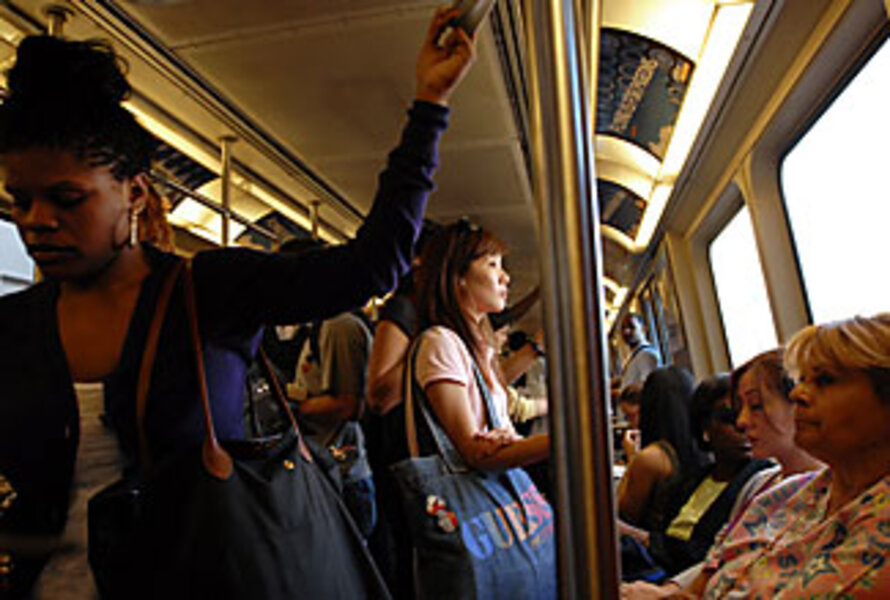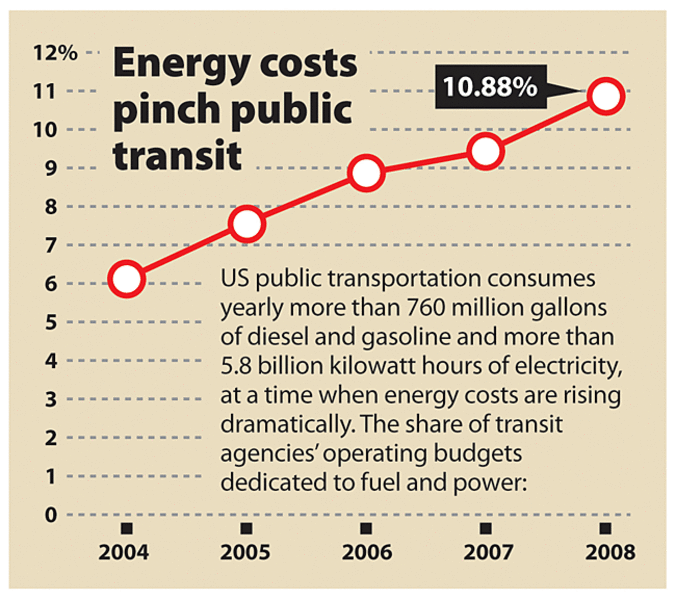Mass transit demand rises, costs soar
Loading...
| NEW YORK
In Seattle, transportation officials plan to add to their daily schedule another three round-trip trains to nearby Tacoma.
In Washington, D.C., commuters on the Metro will soon see many trains expand from six cars to eight.
In New York City, the transportation agency is spending millions of dollars to modernize the subway system's antiquated signaling system, so significantly more trains can travel through its underground tunnels at one time.
Across the US, public-transit officials are scrambling to accommodate a record number of people who are leaving their cars at home and hopping the bus or the train to work.
More than 90 percent of public-transit officials report that their ridership is up over the past three years, according to a survey released this week by the American Public Transportation Association (APTA). And more than 90 percent credited the sky-high gasoline prices.
At the same time, many transit agencies find themselves squeezed by the higher fuel prices and smaller local government subsidies, which are shrinking because of the economic downturn. Almost 70 percent have had to raise fares, and some have even been forced to curtail services to cope with the high energy prices, even as the demand is increasing.
"You've got a time in history where these agencies could be tapping a new market and attracting the suburban people who, heretofore, have been less likely to ride [public transit]," says Stephen Reich, director of the Center for Urban Transportation Research at the University of South Florida in Tampa. "Some agencies are even contracting service because of fuel costs and decreasing government support."
The Seattle area has seen the biggest increase in the number of people riding the commuter rails: up 28 percent from last year. The primary reason is not just gasoline price hikes. Sound Transit, which runs the region's commuter trains, light rail, and buses, is in the process of finishing an ambitious expansion program started 1996. It built commuter-rail lines north and south of Seattle that started operating in 2001. In 2006, only half the number of commuters predicted 10 years earlier were riding the rails. But growth started to pick up in 2006, along with gasoline prices, and now it's going "gangbusters."
"We're growing at a clip that's about what we can do," says Linda Robson, a spokeswoman for Sound Transit. "In fact, we have scheduled to add another three round-trip commuter trains that would run between Tacoma and downtown Seattle, but we are out of space on our layover yard in Tacoma." So they're adding some track and expanding the yard. They'll add two more trains come the fall and a third in 2009, when the construction is finished.
There's a similar story under way in the Miami area, where the South Florida Regional Transportation Authority runs the Tri-Rail commuter trains from Miami to Fort Lauderdale and Palm Beach. In 2006, the agency completed a "double track" corridor improvement program, and since then, the number of riders has grown by between 10 and 20 percent annually. Just this past April, ridership was up 28 percent over a year ago.
"During rush hour, we're basically saying 'Standing room only' at this point," says Bonnie Arnold, a spokeswoman for Tri-Rail. "It's definitely gas-price driven. You talk to passengers, and they say, 'It's all about the gas.' "
For cities like these that have made significant capital improvements, the rising gasoline prices are providing a boon of sorts. Regional planners and local officials often had to fight to spend millions of taxpayer dollars on expanding rail service. It wasn't always popular. Their goal was to shift commuter traffic from the congested roads to more efficient, environmentally sound public transit. But until gasoline prices spiked, many commuters were reluctant to give up the convenience of their cars.
"You've got systems where heavy investments were made, and frankly, they were underutilized," says Professor Reich. "So people are beginning to use that capacity, and that's a great thing. Atlanta is another example of that."
While transportation officials applaud those regions, they also note that only about 5 percent of the American public uses public transportation to commute regularly. In part, that's because only about 20 percent have easy access to trains, subways, and buses. Most of those people are located in the densely populated Northeast and in other urban areas. There, the infrastructure exists, but the ability to expand to cope with increases is somewhat limited. Take New York City.
Transit officials here are in the midst of the biggest subway expansion in several generations. For instance, they're finally building the Second Avenue line that has been planned for decades.
Still, with a 5 percent increase in ridership during the past year, the overall system that was built at the turn of the century is jammed.
"So what we're trying to do is modernize the signaling system that goes back to the Depression area," says Jeremy Sossin, a spokesman for the Metropolitan Transportation Authority. "That will allow us to increase the frequency of trains and move more through during the peak rush hours."
For much of the rest of the country, buses are the primary form of public transportation. They're also the type of transport getting hit hardest by the high fuel prices. In a recent APTA survey, transit officials reported that the diesel prices they pay have jumped from $1.25 a gallon in 2004 to $3.32 today.
During that time, fuel jumped from an average of 6 percent of their operating budgets to almost 11 percent (see chart, above). That's forced changes in the way they operate. Almost 40 percent say they were forced to delay or cancel planned service increases, and the same portion had to transfer funds from their capital budgets to their operating expenses. Almost 20 percent even had to cut service, despite the increase in demand.
The Cleveland area is an example. Last year, the transit agency spent $12 million on fuel. This year, it's expecting fuel to cost as much as $20 million. At the beginning of the year, it cut bus service lines by 5 percent. With the increase now in people looking to hop on the bus, officials are determined not to cut service further. But they still have to find a way to cut their expenses significantly to pay for keeping the buses' fuel tanks full.
"We're looking at cutting overtime to save money," says Chad Self, a spokesman for the Greater Cleveland Regional Transit Authority. But he also hopes the federal and state governments may step in with increased funding. "More people are riding the buses and trains now. Fewer people are driving, so let's hope there's a resolution."






